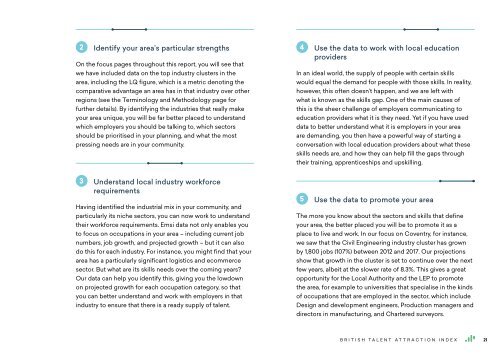British Talent Attraction Index
You also want an ePaper? Increase the reach of your titles
YUMPU automatically turns print PDFs into web optimized ePapers that Google loves.
2 Identify your area’s particular strengths<br />
On the focus pages throughout this report, you will see that<br />
we have included data on the top industry clusters in the<br />
area, including the LQ figure, which is a metric denoting the<br />
comparative advantage an area has in that industry over other<br />
regions (see the Terminology and Methodology page for<br />
further details). By identifying the industries that really make<br />
your area unique, you will be far better placed to understand<br />
which employers you should be talking to, which sectors<br />
should be prioritised in your planning, and what the most<br />
pressing needs are in your community.<br />
4 Use the data to work with local education<br />
providers<br />
In an ideal world, the supply of people with certain skills<br />
would equal the demand for people with those skills. In reality,<br />
however, this often doesn’t happen, and we are left with<br />
what is known as the skills gap. One of the main causes of<br />
this is the sheer challenge of employers communicating to<br />
education providers what it is they need. Yet if you have used<br />
data to better understand what it is employers in your area<br />
are demanding, you then have a powerful way of starting a<br />
conversation with local education providers about what these<br />
skills needs are, and how they can help fill the gaps through<br />
their training, apprenticeships and upskilling.<br />
3 Understand local industry workforce<br />
requirements<br />
Having identified the industrial mix in your community, and<br />
particularly its niche sectors, you can now work to understand<br />
their workforce requirements. Emsi data not only enables you<br />
to focus on occupations in your area – including current job<br />
numbers, job growth, and projected growth – but it can also<br />
do this for each industry. For instance, you might find that your<br />
area has a particularly significant logistics and ecommerce<br />
sector. But what are its skills needs over the coming years?<br />
Our data can help you identify this, giving you the lowdown<br />
on projected growth for each occupation category, so that<br />
you can better understand and work with employers in that<br />
industry to ensure that there is a ready supply of talent.<br />
5 Use the data to promote your area<br />
The more you know about the sectors and skills that define<br />
your area, the better placed you will be to promote it as a<br />
place to live and work. In our focus on Coventry, for instance,<br />
we saw that the Civil Engineering industry cluster has grown<br />
by 1,800 jobs (107%) between 2012 and 2017. Our projections<br />
show that growth in the cluster is set to continue over the next<br />
few years, albeit at the slower rate of 8.3%. This gives a great<br />
opportunity for the Local Authority and the LEP to promote<br />
the area, for example to universities that specialise in the kinds<br />
of occupations that are employed in the sector, which include<br />
Design and development engineers, Production managers and<br />
directors in manufacturing, and Chartered surveyors.<br />
BRITISH TALENT ATTRACTION INDEX 21


